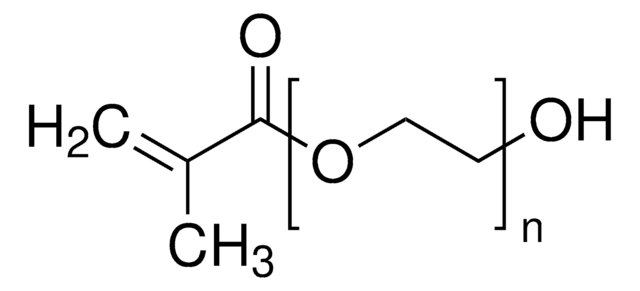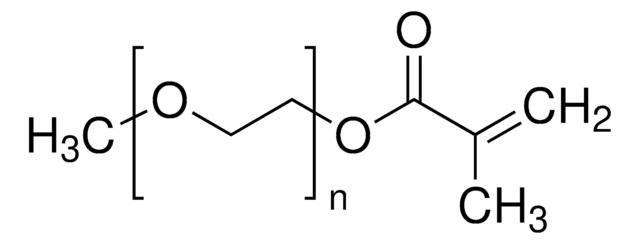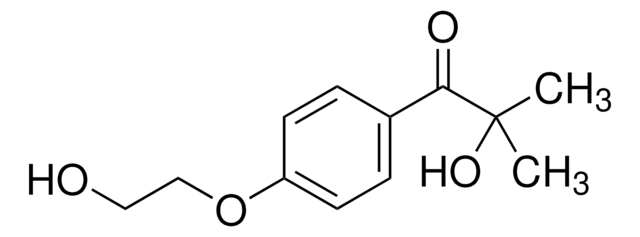Wichtige Dokumente
409510
Poly(ethylenglycol)-dimethacrylat
average MN 550, cross-linking reagent polymerization reactions, methacrylate, 80-120 ppm MEHQ as inhibitor, 270-330 ppm BHT as inhibitor
Synonym(e):
PEG-dimethacrylat
About This Item
Empfohlene Produkte
Produktbezeichnung
Poly(ethylenglycol)-dimethacrylat, average Mn 550, contains 80-120 ppm MEHQ as inhibitor, 270-330 ppm BHT as inhibitor
Form
liquid
Qualitätsniveau
Mol-Gew.
average Mn 550
Enthält
270-330 ppm BHT as inhibitor
80-120 ppm MEHQ as inhibitor
Eignung der Reaktion
reagent type: cross-linking reagent
reaction type: Polymerization Reactions
Brechungsindex
n20/D 1.466
bp
>200 °C/2 mmHg (lit.)
Dichte
1.099 g/mL at 25 °C
Ω-Ende
methacrylate
α-Ende
methacrylate
Polymerarchitektur
shape: linear
functionality: homobifunctional
Lagertemp.
2-8°C
SMILES String
OCCO.CC(=C)C(O)=O
InChI
1S/C10H14O4/c1-7(2)9(11)13-5-6-14-10(12)8(3)4/h1,3,5-6H2,2,4H3
InChIKey
STVZJERGLQHEKB-UHFFFAOYSA-N
Suchen Sie nach ähnlichen Produkten? Aufrufen Leitfaden zum Produktvergleich
Anwendung
- PDGF-AA loaded photo-crosslinked chitosan-based hydrogel for promoting wound healing.: In dieser Studie wird die Verwendung eines photovernetzten Hydrogels auf Chitosanbasis mit Poly(ethylenglykol)dimethacrylat (PEGDMA) untersucht, um PDGF-AA freizusetzen und die Wundheilung zu verbessern. Die Ergebnisse zeigen signifikante Verbesserungen bei den Wundverschlussraten und der Geweberegeneration (Cai et al., 2024).
- Reducing the foreign body response on human cochlear implants and their materials in vivo with photografted zwitterionic hydrogel coatings.: In dieser Studie wird die Anwendung von PEGDMA bei zwitterionischen Hydrogelbeschichtungen untersucht, um Fremdkörperreaktionen bei Cochlea-Implantaten zu minimieren. Die Beschichtungen reduzierten die Entzündung signifikant und verbesserten die Biokompatibilität in vivo (Horne et al., 2023).
- Full factorial design of experiment-based and response surface methodology approach for evaluating variation in uniaxial compressive mechanical properties, and biocompatibility of photocurable PEGDMA-based scaffolds.: Diese Studie verwendet ein vollständiges faktorielles Design zur Optimierung der mechanischen Eigenschaften und Biokompatibilität von Gerüsten auf PEGDMA-Basis und unterstreicht deren potenziellen Einsatz in der Gewebetechnik und regenerativen Medizin (Bharadwez et al., 2023).
- Antifouling and Mechanical Properties of Photografted Zwitterionic Hydrogel Thin-Film Coatings Depend on the Cross-Link Density.: In diesem Artikel wird untersucht, wie sich die Veränderung der Querverbindungsdichte in Hydrogelbeschichtungen auf PEGDMA-Basis auf ihre Antifouling- und mechanischen Eigenschaften auswirkt. Die Ergebnisse sind relevant für die Entwicklung strapazierfähiger und biokompatibler Beschichtungen für Medizinprodukte (Jensen et al., 2021).
- Biocompatible and photocrosslinkable poly(ethylene glycol)/keratin biocomposite hydrogels.: Die Forschungsarbeit präsentiert die Entwicklung von PEGDMA/Keratin-Biokomposit-Hydrogelen, die eine ausgezeichnete Biokompatibilität und mögliche Anwendungen in Wirkstoffabgabesystemen und Gewebetechnik zeigen (Wang et al., 2021).
Lagerklassenschlüssel
10 - Combustible liquids
WGK
WGK 1
Flammpunkt (°F)
Not applicable
Flammpunkt (°C)
Not applicable
Hier finden Sie alle aktuellen Versionen:
Besitzen Sie dieses Produkt bereits?
In der Dokumentenbibliothek finden Sie die Dokumentation zu den Produkten, die Sie kürzlich erworben haben.
Kunden haben sich ebenfalls angesehen
Artikel
Patterning of PEG-based Hydrogels - Engineering Spatial Complexity
Progress in biotechnology fields such as tissue engineering and drug delivery is accompanied by an increasing demand for diverse functional biomaterials. One class of biomaterials that has been the subject of intense research interest is hydrogels, because they closely mimic the natural environment of cells, both chemically and physically and therefore can be used as support to grow cells. This article specifically discusses poly(ethylene glycol) (PEG) hydrogels, which are good for biological applications because they do not generally elicit an immune response. PEGs offer a readily available, easy to modify polymer for widespread use in hydrogel fabrication, including 2D and 3D scaffold for tissue culture. The degradable linkages also enable a variety of applications for release of therapeutic agents.
Devising biomaterial scaffolds that are capable of recapitulating critical aspects of the complex extracellular nature of living tissues in a threedimensional (3D) fashion is a challenging requirement in the field of tissue engineering and regenerative medicine.
Unser Team von Wissenschaftlern verfügt über Erfahrung in allen Forschungsbereichen einschließlich Life Science, Materialwissenschaften, chemischer Synthese, Chromatographie, Analytik und vielen mehr..
Setzen Sie sich mit dem technischen Dienst in Verbindung.







